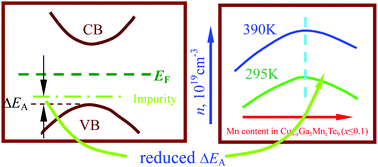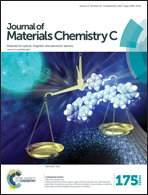Engineering the energy gap near the valence band edge in Mn-incorporated Cu3Ga5Te9 for an enhanced thermoelectric performance†
Abstract
Cu3Ga5Te9-based compounds Cu3−xGa5MnxTe9 (x = 0–0.2) with Mn substitution for Cu have been synthesized. The engineered energy gap (ΔEA) between impurity and valence bands is reduced from 44.4 meV at x = 0 to 25.7 meV at x = 0.1, which is directly responsible for the reduction of the potential barrier for thermal excitation of carriers and the increase in carrier concentration. However, the Seebeck coefficient shows an increasing tendency with the increase of determined Hall carrier concentration (n). This anomalous behavior suggests that the Pisarenko plots under assumed effective masses do not fit the current relationship between the Seebeck coefficient and the carrier density. With the combination of enhanced electrical conductivities and reduced thermal conductivities at high temperatures, the maximum thermoelectric (TE) figure of merit (ZT) of 0.81 has been achieved at 804 K with x = 0.1, which is about 1.65 and 2.9 times the value of current and reported intrinsic Cu3Ga5Te9. The remarkable improvement in TE performance proves that we have succeeded in engineering the energy gap near the valence band edge upon Mn incorporation into Cu3Ga5Te9.



 Please wait while we load your content...
Please wait while we load your content...